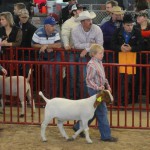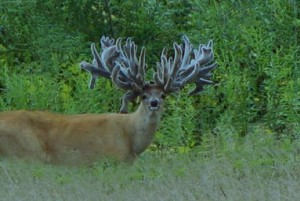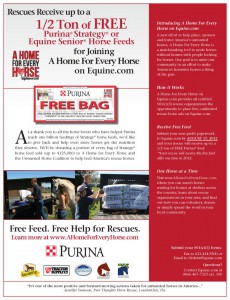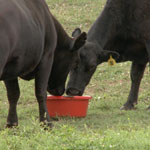Broodmares have specific nutritional requirements that differ from other classes of horses. There are differences both in the amount of feed mares need and the nutrient concentration needed in that feed. Throughout the year the broodmare goes through three different phases, each with a different nutritional demand. She is either in early gestation, late gestation or lactation. To keep this cycle going consistently requires that the mare receive the proper health care and nutrition.
Body Condition Affects Reproductive Performance
Body condition may be the single largest factor affecting the reproductive performance of mares. Mares maintained in moderate to fleshy condition cycle earlier in the year, require fewer cycles per conception, have a higher pregnancy rate and are more likely to maintain pregnancies than are thin mares. Because of the subjective nature of terminology such as “fleshy”, “good condition”, etc., researchers developed a numeric scoring system to objectively identify the body condition of a mare. Using this system, research has determined that a condition score of less than 5 in lactating mares indicates that they may not have enough stored body fat to support efficient reproductive performance. Those mares are more likely to skip a breeding season than are mares with a condition score of 6 or more. This is especially prevalent in mares that are 15 years of age or greater.
Reproductive performance often can be improved in thin mares when they are fed to gain weight. However, putting weight on a thin mare, particularly during lactation can be costly and dangerous due to the high levels of feed intake required to achieve gain. While no foaling difficulties have been shown in mares in obese condition, there are no reproductive advantages to keeping mares in condition scores of 8 or 9. Therefore, scores of 5.5 to 7.5 represent the optimum. Management of body condition should be supported by careful selection of feedstuffs and accurate ration formulation, because this is an important step in promoting normal foal growth (see Body Condition Scoring Chart).
Total Feed Intake
Total daily feed intake by mares (hay + concentrate) normally ranges from 1.5 percent to 3.0 percent of body weight, with 2 percent serving as an average. Actual daily feed intake depends on the type and quality of hay or grazing and on the crude fiber level and energy density of the concentrate. As the fiber level increases and energy density decreases, the amount of feed required to meet energy demands will go up. However, as forage quality decreases, voluntary intake often decreases as well. This can present a problem in providing enough energy to maintain the desired body condition. Furthermore, daily feed intake can vary between individuals. Feed intake may have to be increased for hard keepers or heavy milkers, and decreased for other mares who are easier keepers.
Early and Mid-gestation
A non-lactating, pregnant mare in the first 8 months of gestation has nutrient requirements very similar to those of any mature, idle horse. The developing foal gains only 0.2 pounds/day during this time and does not present a significant nutritional demand on the mare. It is usually considered sufficient simply to meet the mare’s nutrient requirements for maintenance.
This may be accomplished with free choice grazing of quality pasture. In this situation, mares may consume as much as 3 percent of their body weight, which can meet their needs for protein and energy during this stage. However, mineral requirements may not be met, particularly in mineral deficient pastures. Therefore, supplemental minerals will be necessary. This may be accomplished with a free-choice loose mineral or a mineral block for horses. A trace mineralized salt block will not provide sufficient mineral to meet requirements, therefore it is recommended that a free-choice mineral and a salt block be provided at this time. High quality hays can also be excellent for maintaining dry, pregnant mares in the early stages of pregnancy. As an average, mares will require around 2 percent of their body weight in high quality hay if no supplemental grain is used. Grazing and/or hay will usually maintain a mare that is already in acceptable body condition, but often will not put sufficient weight on mares that are in marginal condition.
When pasture or hay quality declines, or is not available in adequate amounts, mares will need supplemental concentrate to maintain body weight and condition. A quality concentrate fed at .5 to .75 percent of body weight will help keep mares in good shape.
Late Pregnancy
As a mare enters the last 3-4 months of pregnancy, nutrient requirements increase because the unborn foal is growing more rapidly, averaging 1 pound/day. During this time the intake of protein, energy, vitamins and minerals needs to be increased. Even in situations where forage is sufficiently maintaining mares in acceptable condition, it is important that they receive quality concentrate supplementation. While forage may be able to provide sufficient calories to maintain the body condition of the mare, other nutrients, particularly protein and minerals, will be inadequate. Research has shown that foal birth weight can be adversely affected when mares do not receive adequate protein during late gestation, even when the mares maintain a condition score of 5.5 to 7.5. Therefore, simply having mares stay in good condition during late gestation does not guarantee proper foal development.
It is during the tenth month that the greatest amount of mineral retention occurs in the unborn foal. In addition to this, mares’ milk is practically devoid of trace minerals, such as copper, that are essential for proper bone development. Therefore, adequate mineral nutrition of the mare is critical for normal fetal development and to provide sufficient minerals for the foal to be born with stores of these nutrients to draw upon after birth. A supplemental feeding program that provides a good protein, vitamin and mineral balance is necessary to properly support the growth and development of the foal. Diets containing added fats or oils can be used to help mares in unsatisfactory condition gain the desired weight.
The advantage of feeding these diets is that body condition can be improved without having to feed excessive amounts of concentrate, since the higher fat diets tend to have a higher digestible energy level.Lactation
At foaling, a mare’s daily nutrient requirements increase significantly. The protein and energy requirements almost double from early gestation to lactation, as do requirements for calcium, phosphorus and Vitamin A. These nutrient needs must be met in order for the mare to recover from foaling stress, produce milk and to rebreed, all without losing body condition. This is a critical, nutritional period for the mare. Underfeeding of mares during early lactation will surely lower milk production and cause weight loss. This may not pose a problem if the mare is in fleshy to fat contition. However, early lactation weight loss in mares that foal in thin condition will often affect the mare’s ability to raise her new foal and become pregnant again.
Mares produce an average of 24 pounds (3 gallons) of milk daily during a 5-month lactation. This represents 450 gallons or 1 3/4 tons of milk over 150 days. High producing mares produce as much as 32 pounds (4 gallons) of milk daily. The average production in the first 22 days of lactation is 26.5 pounds per day. Production appears to reach a peak at 30 days and slowly decline from there. Nutrient content of mares’ milk follows a more drastic downward curve. In the fourth month of lactation, a mare’s milk provides less than 30 percent of the total energy needed by her foal. Providing lactating mares with a concentrate that includes added fats or oils and high quality protein can help slow the downward curve of production and improve nutrient content of the milk. This will translate into an early growth advantage for the nursing foal.
A lactating mare will usually consume between 2 and 3 percent of her body weight in total feed (hay + concentrate) daily. Because of the significant difference in nutrient requirements from gestation to lactating, it would be safer for a gradual increase in feed intake to begin prior to foaling. This would prevent a drastic change at foaling time, which could increase the risk of digestive disorders. Also, providing the total daily feed in two equal feedings allows mares to more safely consume the amounts needed during lactation. Heavy milkers may require as much as 1.75 percent of body weight in concentrate feed each day, depending on the quality and nutrient density of that concentrate.
When possible, mares fed in groups should be sorted according to feed intake or body condition to insure each mare receives the appropriate amount of concentrate to meet her needs. Providing individual feed troughs for each mare plus one extra trough for mares that get run off from their feed, or providing plenty of space at group troughs will help insure that mares consume the feed they need.
Free choice spring grazing will meet some of the mare’s nutrient requirements, but considerable amounts of supplemental concentrate will be needed. Less supplemental feed will be needed for mares grazing on small grain pastures. In most cases, body condition of mares on high quality pasture or hay can be maintained with concentrate provided at .75 to 1.25 percent of body weight daily. This will vary significantly depending on the quality and quantity of forage available and the nutrient content of the concentrate.
In the fourth, fifth and sixth months of lactation, daily requirements begin to decline. However, by this time many horsemen will have had foals on a good creep feed to prepare them for weaning and will be weaning by the fourth or fifth month of age. There is no advantage for the foal to remain on the mare past this time. It is more nutritionally accurate for the foal and more economical for the horseman to feed the foal a quality diet to meet his needs directly than it is to feed the mare to produce milk. Once the foal is weaned, the dry, pregnant mare can be managed as an early gestating mare once again. Through proper health care, feeding management and breeding techniques, the mare can produce a strong, healthy foal each year.By Karen E. Davison, Ph.D., Managing Equine Nutritionist, Purina Mills, LLC
 With the Ft. Worth, San Antonio, and Houston Stock Show’s around the corner, many student’s are working on with their animals as they prepare for the stock show season.
With the Ft. Worth, San Antonio, and Houston Stock Show’s around the corner, many student’s are working on with their animals as they prepare for the stock show season.





